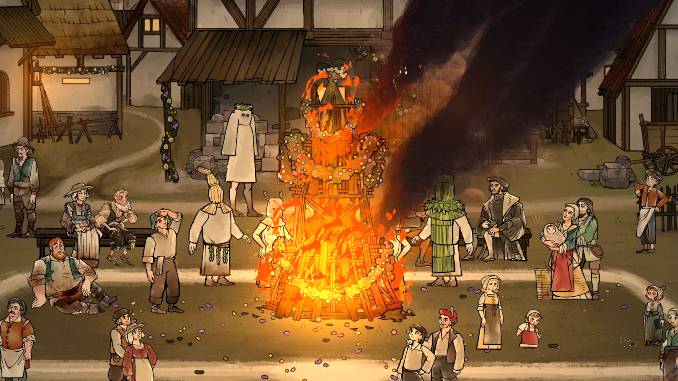Pentiment Conveys the Importance of Contending With And Preserving History

Pop culture doesn’t have the best track record of depicting the past. While there are certainly exceptions, stereotypes define many historical portrayals as entire eras are reduced to a handful of cartoonish symbols. Renditions of the Middle Ages are a perfect example, conjuring images of religious zealotry, uncleanliness, and general ignorance. In videogames, series like Assassin’s Creed best embody the medium’s treatment of history, and although there is an admittedly campy charm to somehow bumping into every important Renaissance figure in Assassin’s Creed 2 while fumbling through incoherent ancient alien nonsense, much can be gained from a more grounded approach.
Pentiment, the latest from Obsidian Entertainment, not only delivers this approach, but engages with the reasons why it’s beneficial to remember the complexities of the past at all. Through its setting, emphasis on the passage of time, and main conflicts, Pentiment constantly draws attention to how history shapes what we believe and who we think we are. It is about the struggle over these narratives and how their nuances are paved over, sometimes accidentally but frequently intentionally. By constructing such a meticulous portrayal of its time period, it allows us to reckon with our conceptions of what came before, underscoring the wrinkles and contradictions that exist in any era. Set in 16th century Bavaria, nearly every layer of this experience ruminates on the past, including its setting. Pentiment’ s central locations, Kiersau Abbey and the nearby town of Tassing, are built on Roman ruins, with aqueducts and shattered alabaster statues from the height of the Eastern Roman Empire lining the landscape. As local peasants till the land, they find trinkets from long ago buried in their soil, such as pottery and tools from antiquity. This town is a reminder that even those from a former age contended with distant history.
Despite being a remote alpine village, Tassing is also a center of cultural changes. As a community under the rule of a Benedictine abbey during the Roman Catholic church’s declining power, we see firsthand as the Protestant Reformation begins to rip through Christendom, causing debates over Lutheranism and the church’s authority. Additionally, the abbey’s scriptorium, where Pentiment’s protagonist Andreas Maler works, is also on its way out as the proliferation of the printing press leaves its style of book production obsolete. The promise of major socio-economic upheavals looms as peasant uprisings throughout the region challenge the feudal system. These details liven what we may mistake for static history and add a great deal of texture to Pentiment’s portrayal of this era. Furthermore, the game references the past in its aesthetic framing, as the art style emulates the look of late Middle Ages manuscripts and early modern woodcuts. When the scene changes, the camera zooms out, revealing that we’re viewing a series of illustrations in a book. Similarly, dialogue is presented via text boxes that are either handwritten or printed press, positioning this tale as a primary source document.
And on top of how Pentiment’s setting, premise, and visual framing contribute to its historicity, its characters and their struggles also reiterate the many nuances of the past. We witness as children grow up, family members die, and the makeup of the village shifts. Traumatic events scar the town across generations, and even children who weren’t alive to see them are pulled along by currents of collective pain.Pentiment’s cast also displays the diversity of viewpoints and identities that existed in early modern Bavaria. Many of the women in this story, including the nun Sister Illuminata, show they are keenly aware they live within a patriarchal system and criticize the discrimination they face. Multiple people of color, including an Ethiopian monk visiting the abbey and a Romani man who challenges the church’s teachings, convey that even in this remote village, there were more than just lily-white faces. There are also several queer characters, highlighting that despite the religious conservatism of the time, there were obviously still people of many sexual orientations. These depictions erode a vision of Europe that prevails in stereotypes, reinforcing instead that it has never been an entirely homogeneous block and that ideological and identity-based diversity existed even at the height of the Christian church’s power.
Taken as a whole, Pentiment intends to expose the complexities of a traditionally oversimplified era. It shows how people living in the early modern period were not some indistinguishable blob of ignorance but had their own personalities, convictions, and beliefs. For history lovers, discovering these details is a reward in itself, but Pentiment’s narrative makes clear that documenting the past isn’t just for hobbyists and academics. Our understanding of what came before is essential for how we process the present. The notion that these stories directly impact elements of our daily lives becomes the driving force of its denouement.
Warning: From here on out, there are heavy spoilers about the game’s plot and ending. You’ve been warned!